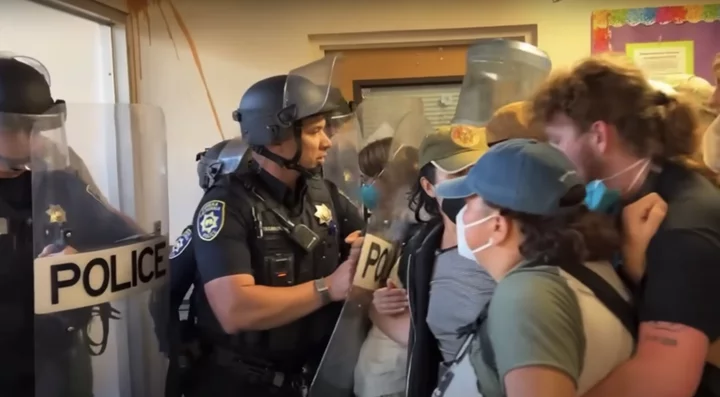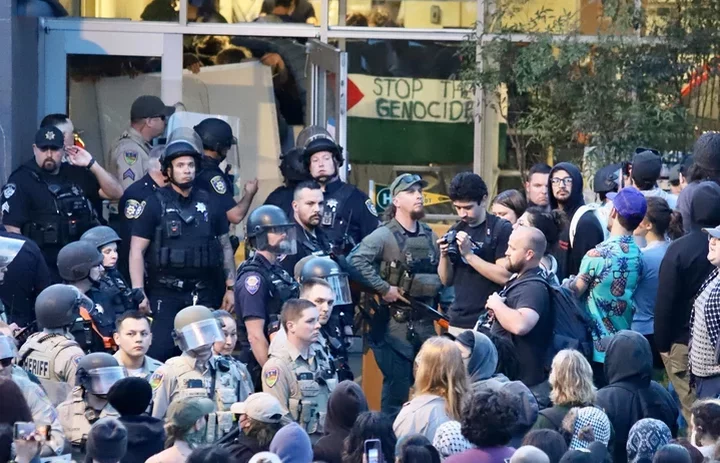Police officers clash with protesters inside Siemens Hall at Cal Poly Humboldt on April 22. | Screenshot of video by Ryan Hutson for Redheaded Blackbelt.
###
Law enforcement’s clash with pro-Palestinian protestors at Cal Poly Humboldt on April 22 revealed a lack of effective planning and command, according to an independent review conducted by OIR Group, the Long Beach-based entity that serves as the City of Eureka’s Independent Police Auditor (“IPA”).
Of course, the Eureka Police Department was not the lead agency that responded to the campus demonstration — that would be Cal Poly Humboldt’s own University Police Department (UPD), which has not, to our knowledge, had its own independent review.
But the report commissioned by Eureka and presented to the public earlier this week found the planning and execution of law enforcement’s initial response sorely lacking.
“There was no clear unified Incident Command, and no contingency planning in place if the circumstances changed; for example, how to respond if the crowd size overwhelmed law enforcement’s capacity or protestors became violent,” the report notes. “Those in command did not account for field operation basics, such as covering all entrances to Seimens [sic] Hall, avoiding being surrounded, and providing a safe and clear path of movement for those who left voluntarily as well as arrestees.”
The report also suggests that the violent altercation — video of which, including a protester’s water jug going “boink” across a cop’s helmet, quickly went viral — could probably have been avoided altogether.
“Based on our review of available video and other evidence, there was no immediate threat beyond vandalism of University property at the time officers staged in the foyer, and no urgent need for law enforcement intervention,” the OIG report states.
The 26-page review, which you can download via the link below, offers a blow-by-blow account of the April 22 events on campus along with a list of half a dozen recommendations for the Eureka Police Department.
The writeup says that while protesters said their intention was to peacefully “sit-in” to protest the war in Gaza, those intentions “were soon overshadowed by some protestors’ involvement in vandalism of University property and their decision to barricade entrances and exits [to Siemens Hall], prompting University administration to request a law enforcement intervention.”
EPD was among several local agencies to respond to the university’s call for mutual aid. About an hour into the protest, university leadership reportedly gave the command for law enforcement to enter Siemens Hall and arrest protesters for trespassing.
According to the report, things went sideways pretty quickly. While the plan was to enter Siemens Hall from a rear upstairs door and push protestors out the front door, to be arrested by waiting officers, UPD instead directed the team through the main quad to that front door, where approximately 50 protesters had gathered in force.
As the crowd of protesters outside crowded in behind the team of officers, they saw that the foyer inside Siemens Hall’s main entrance had been blocked by heavy cabinets, bookshelves, desks and chairs. This was a surprise to the EPD officers because UPD had reported that all barricades had been removed, the report says.
“At this point, the EPD team recognized that law enforcement was significantly outnumbered,” the review continues. “The mission as initially described – to arrest 30 peaceful protestors – was not the actual situation faced by EPD officers on the ground. … Moreover, the EPD officers appeared to be the only responding team equipped with shields that were required for effective crowd management.”
As the assembled officers gathered outside, protesters yelled at them to leave, and some started throwing unopened cans of food in their direction.
“Others began to jump in unison and chant loudly, saying, ‘we are not afraid of you!’” the report says. “A protestor banged an empty water jug with a stick. Still others asserted that they were conducting a prayer ritual that could not be interrupted; one stood on the furniture and burned sage while holding an abalone shell.”
Two dispersal orders were given, but with all the noise on scene it’s unclear whether the protesters could hear them.
“Video footage from all vantage points suggested that the officers were at a tactical disadvantage, both in sheer numbers and force,” the report says. But under direction from the university, they advanced nonetheless. “The power of the surging crowd appeared to be stronger as the officers lost ground nearly immediately. Still, the officers used their shields to continue to push into the crowd.”
Protesters kicked, punched, spat and shoved; cops used their batons to poke and jab while shoving back. One officer punched a protester in the torso with a closed fist. A female officer’s knees buckled as she was pushed into a cabinet, and as she lay on the ground being choked by the chin strap of her own helmet, a protester struck her repeatedly in the right leg, according to the report. She kicked back, “possibly kicking a protestor in the groin.”
Again, the report points the finger at the university and UPD.
“[An EPD] supervisor expressed concerns about the mission several times, including concern over not having an effective arrest plan,” it says. “While UPD wanted to issue another dispersal order and begin moving or arresting the crowd in the quad, EPD and others advised to wait.”
Undeterred, UPD requested an armored vehicle and a SWAT team.
The EPD officers managed to extricate themselves, and by 10:40 p.m. they had pulled all resources from the campus.
Since OIR Group is the City of Eureka’s independent auditor, it’s official list of recommendations is directed toward the city and its police force. But the analysis doesn’t spare UPD.
”As the lead organization, UPD was responsible for planning and command, and should have created a written Incident Action Plan (also referred to as Operational Plans, or “Ops Plans”) for this event,” the report says. And ultimately, the review commends EPD as far more prepared and equipped than the university’s force.
“EPD command staff had the expertise (backed by its own First Amendment Assembly policy) needed to effectively resolve the short-term situation on campus, and to develop effective operations plans for related events that occurred in the following weeks,” the report says. “We advise that EPD use this expertise to lead the region in establishing templates for Incident Action Plans for spontaneous events.”
Perhaps surprising: The report says EPD does not have a mutual aid agreement with regional partners such as UPD.
OIR Group’s six recommendations for EPD are as follows:
- “EPD should work with its regional partners to establish templates for Incident Action Plans for various types and sizes of events that provide general strategy and working tactics.”
- “EPD should work with its regional partners to establish a Mutual Aid Agreement and a regional training plan to ensure that all parties fully understand the contours of the Agreement.”
- “EPD should develop a formal critical or major incident review process that involves a meeting of Department leaders convened after a critical incident, in which a broad range of issues are considered and identified, and which results in clearly defined and documented action items with expectations for follow-up and effective feedback.”
- “EPD should engage with the other agencies who responded to Cal Poly on April 22 to facilitate a multi-agency debrief to discuss where improvements can be made in future responses.”
- “EPD should send at least one supervisor to obtain Mobile Field Force instructor certification in Field Force Operations. Once certified, this trainer should provide a Mobile Field Force training update to all personnel.”
- “EPD should add Mobile Field Force updates to its regular training schedule (while balancing competing training requirements and staffing challenges).”
In closing, the report commends EPD for its actions during these less-than-ideal circumstances:
EPD’s role in the law enforcement response to the April 22 protest at Cal Poly was limited and, at least initially, claimed no responsibility over the planning and on-scene command. The officers and supervisor who arrived first at the University were thrust into a difficult task with little or no chance of success. And as we detail above, their use of force to get out of that situation was measured and justified.
Law enforcement officers arrested 31 protesters during the demonstrations, though none have yet been charged with any crimes. Reached by the Outpost earlier this week, Humboldt County District Attorney Stacey Eads said her office has conducted its initial review.
“Final decisions are pending further evaluation and/or receipt of additional information,” she said via email.
###
###
File photo from the April 22 incidents at Cal Poly Humboldt by Andrew Goff.
PREVIOUSLY:
- Multiple Law Enforcement Agencies on CPH Campus This Morning; Solidarity March Planned; Commencement Ceremony Status Uncertain
- In New Statement, Cal Poly Humboldt Says It Supports Free Speech But Decries ‘Lawless Behavior,’ Disruption of Education and Damages Estimated in the Millions
- Cal Poly Humboldt Issues Hard Closure of Campus; Law Enforcement Converges
- DAY FIVE: Protesters Open Cal Poly Humboldt’s Siemens Hall After Day of Tension Waiting For a Raid That Has Yet to Come
- DAY FOUR: Occupy Cal Poly Humboldt Protester Details Group’s Demands, Motivations and Views on President Tom Jackson, Law Enforcement and Their Campus Impact
- Cal Poly Humboldt Faculty Pass Vote of No Confidence in President Tom Jackson Amid Ongoing Student Protest
- DAY THREE: (PHOTOS) Student Protesters List Demands, Expand Graffiti Messaging and Voice Camaraderie on Third Day of Cal Poly Humboldt Campus Occupation
- Cal Poly Humboldt Says Campus Will be Closed Through at Least the Weekend Due to Ongoing Pro-Palestine Protests
- DAY TWO: The Morning After Cops Clash With Student Protesters, CPH Campus is Closed, Occupied Building Barricaded
- Legendary Rebellious Rapper Chuck D’s Cal Poly Humboldt Event Canceled By In-Progress, On-Campus Rebellion
- DAY ONE: Major Pro-Palestine Protests at Cal Poly Humboldt Provoke Massive Police Response; Protesters Occupy Siemens Hall; Reports of Violent Force Between Activists and Law Enforcement


CLICK TO MANAGE